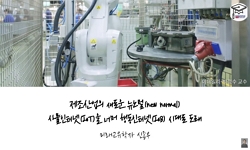본 논문은 소비자와 스마트 객체간의 연결을 통해 생성된 어셈블리지 안에서 이들이 서로 상호작용하는 경험에 대해 연구하였다. Hoffman & Novak (2018)이 제시한 어셈블리지 인에서의 소비자의 ...
http://chineseinput.net/에서 pinyin(병음)방식으로 중국어를 변환할 수 있습니다.
변환된 중국어를 복사하여 사용하시면 됩니다.
- 中文 을 입력하시려면 zhongwen을 입력하시고 space를누르시면됩니다.
- 北京 을 입력하시려면 beijing을 입력하시고 space를 누르시면 됩니다.

소비자와 인공지능스피커 관계형성에 대한 연구: 네트노그라피(Netnography) 분석 = Exploring Consumer-AI Speaker Relationships: A Netnographic Approach
한글로보기https://www.riss.kr/link?id=A107746456
- 저자
- 발행기관
- 학술지명
- 권호사항
-
발행연도
2021
-
작성언어
-
-
주제어
소비자-스마트객체 관계 ; 사물인터넷 ; 인공지능스피커 ; 배치이론 ; 어셈블리지 ; 네트노그라피 ; Consumer-smart object relationship ; IoT ; AI speaker ; Assemblage theory ; Netnography
-
등재정보
KCI등재
-
자료형태
학술저널
- 발행기관 URL
-
수록면
33-65(33쪽)
- DOI식별코드
- 제공처
-
0
상세조회 -
0
다운로드
부가정보
국문 초록 (Abstract)
본 논문은 소비자와 스마트 객체간의 연결을 통해 생성된 어셈블리지 안에서 이들이 서로 상호작용하는 경험에 대해 연구하였다. Hoffman & Novak (2018)이 제시한 어셈블리지 인에서의 소비자의 4가지 경험, 즉 Self-extension, Self-expansion, Self-restriction, Self-reduction을 적용하여 구글홈을 사용하는 고객들의 SNS 및 커뮤니티 글들을 네트노그라피 방법론을 활용하여 분석하였다. 분석 결과, 4가지 경험과 하위 theme 7개, 즉 아웃소싱, 이미지향상, 공감, 자신감, 신체활동조절, 정서조절, 자아존중감 저하를 발견하였다. 이든 경험들을 통해 소비자들은 자신의 능력을 구글홈에 이전함으로써 어셈블리지의 역량을 안정화 시키고 확장하기도 하며, 자신의 신체능력, 감정 조절 동기로 인해 구글홈의 능력이 확장되는 것을 제한하기도 한다. 한편, 소비자들은 구글홈과의 어셈블리지 안에서 다양한 역량을 이전 받아 자신의 이미지를 높이며, 감정이 안정되며, 자신감도 가질 수 있게 되기도 하며, 어셈블리지 안에서 자신의 자신감 저하로 인한 역량이 감소되는 것을 경험하기도 한다. 본 연구는 소비자와 스마트 객체간의 상호작용을 연구하는 연구자 및 이를 활용하여 고객에게 가치를 제공하는 마케터들에게 시사점을 제공하고 있다.
다국어 초록 (Multilingual Abstract)
This study seeks to explore the interactions between consumers and smart objects within an assemblage where consumers and smart objects are connected and work together. We adopt the framework of consumers’ four experiences (i.e., self-extension, sel...
This study seeks to explore the interactions between consumers and smart objects within an assemblage where consumers and smart objects are connected and work together. We adopt the framework of consumers’ four experiences (i.e., self-extension, self-expansion, self-restriction, and self-reduction) developed by Hoffman & Novak (2018). Drawing from a netnographic approach with Google Home community contents and Instagram photos, we validate Hoffman and Novak’s framework of consumers’ four experiences within an assemblage resulting from the consumers-Google Home ongoing interactions, and find seven themes under the four experiences: outsourcing, image improvement, empathy, confidence, physical activity regulation, emotion regulation, and low self-esteem. The results indicate that consumers could actively enhance as well as limit the capacities of assemblage by adding (e.g., outsourcing) or removing the components of assemblage (e.g., regulating). In addition, consumers could have more capacities (e.g., image improvement, empathy, confidence) or fewer capacities (e.g., loss of self-esteem) by being part of an assemblage. The current study provides some meaningful implications for marketers managing consumer-object touchpoints and insights for academics by extending the assemblage theory and netnographic approach to examining interactions between consumers and smart objects.
동일학술지(권/호) 다른 논문
-
한국 OTT 시장에서의 글로벌-로컬 OTT간 경쟁상황 시나리오 분석
- 정보통신정책학회
- 손창원 ( Changwon Son )
- 2021
- KCI등재
-
프라이버시 염려가 디지털 콘텐츠 지출에 미치는 영향: 이부모형을 이용한 실증분석
- 정보통신정책학회
- 신일순 ( Ilsoon Shin )
- 2021
- KCI등재
-
생산함수를 활용한 주파수의 경제성 평가: 이동통신 산업을 중심으로
- 정보통신정책학회
- 변희섭 ( Hee Sub Byun )
- 2021
- KCI등재




 KISS
KISS






